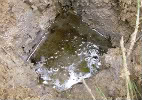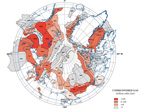With the news that the amount of oil leaking from below the surface of the Gulf of Mexico could be as much as five times the original estimate put forward by British oil-giant BP, the situation moved from worrisome to desperate.
It is now believed that the 5,000 barrels of oil (210,000 gallons) are leaking from the ocean floor everyday, as opposed to 1,000 barrels of oil a day which BP originally estimated. As the oil slick was reported to be within hours of hitting the Louisiana coastline, a state of emergency was declared. The Gulf of Mexico coast is home to hundreds of species, including dolphins, birds, alligators, and turtles.
Regional fishermen are also dismayed as the Gulf of Mexico is one of America’s richest fishing grounds and it is currently peak spawning time for many of the area’s targeted marine life. Louisiana shrimpers have already filed a lawsuit against BP for economic losses due to the spill.
Oil started spilling after an explosion last week on BP’s Deepwater Horizon oil rig that left eleven people ‘presumed dead’. Remote vehicles were unable to fix the plug and now the newest plan is to cap the leak, a process that will take four weeks and is not certain to succeed.
Labeling the spill of ‘national significance’, the US government has now stepped in to help deal with cleaning the spill and mitigating its impact—including an option to mobilize the military—though the government says BP will be responsible for all costs.
According to the Guardian BP recently lobbied hard—and succeeded—against tougher environmental requirements for off-shore drilling, including a remote-controlled switch that if working properly could have stopped the spilling. The device is required by Norway and Brazil, but not the US.
The spill also puts the Obama Administration in a difficult position, having announced last month a new plan to allow offshore drilling along the northern coast of Alaska, the eastern coast, and the Gulf of Mexico, essentially opening up millions of acres that had long been off the table to oil interests. While applauded by some Republicans and the oil industry, the plan was vigorously opposed by environmental organizations, as well as some coastal governors and senators.
At the same time, Virginia Governor Bob McDonnel said today that the spill will not deter him from pushing Virginia to be the first state on the East Coast to begin off-shore drilling.
The US consumes more oil than any other country in the world. In 2007 the US consumed over 20 million barrels of oil everyday: nearly three times the number two consumer, China. As far as production, the US comes in third after Saudi Arabia and Russia; it is the world’s largest export.
Headlines since the spill have changed from “Drill, Baby, Dill”, a mantra from pro-drillers, to “Spill-Baby-Spill”, a reflection of the environmental costs of humankind’s continuing reliance on fossil fuels.
Related articles
NASA satellite image reveals massive oil spill
(04/26/2010) A newly released NASA satellite image reveals oil leaking from the BP oil rig that sank after it exploded April 20, 2010. The explosion killed 11 workers.
After oil rig explosion, leaking crude threatens Gulf of Mexico
(04/26/2010) Just weeks after a Chinese coal barge rammed the Great Barrier Reef, cutting a nearly two-mile swath through the reef and spilling three tons of engine fuel, fragile marine ecosystems are again threatened. Last Tuesday a BP oil rig platform exploded in the Gulf of Mexico, likely killing eleven workers. The blast also left oil leaking from the drill hole estimated at 42,000 gallons (or 1,000 barrels) of oil per day.
Half a trillion spent on fossil fuel subsidies mostly “a complete waste of money”
(04/22/2010) Despite a warming planet linked to the burning of fossil fuels, governments around the world still spend 500 billion US dollars a year subsidizing fossil fuel industries. A new study from the Global Subsidies Initiative (GSI) of the International Institute for Sustainable Development looks at the difficult political situation behind ending fossil fuel subsidies.
Under siege: oil and gas concessions cover 41 percent of the Peruvian Amazon

(02/16/2010) A new study in the Environmental Research Letter finds that the Peruvian Amazon is being overrun by the oil and gas industries. According to the study 41 percent of the Peruvian Amazon is currently covered by 52 separate oil and gas concessions, nearly six times as much land as was covered in 2003. “We found that more of the Peruvian Amazon has recently been leased to oil and gas companies than at any other time on record,” explained co-author Dr. Matt Finer of the Washington DC-based Save America’s Forests in a press release. The concessions even surpass the oil boom in the region during the 1970s and 80s, which resulted in extensive environmental damage.
Fossil fuel subsidies “bringing us closer to irreversible climate change”
(11/06/2009) The Green Economy Coalition is urging G20 finance ministers to rapidly put an end to fossil fuel subsidies. In a letter to the ministers the coalition argues that these subsidies are contributing directly to climate change and making it difficult for the world to transition to a greener economy.
US subsidies of oil and coal more than double the subsidies of renewable energy
(09/21/2009) During the fiscal years of 2002-2008 the United States handed out subsidies to fossil fuel industries to a tune of 72 billion dollars, while renewable energy subsidies, during the same period, reached 29 billion dollars.
Heavy oil pollution remains in Amazon, despite company claiming clean-up is finished

(09/17/2009) A new report shows that the Corrientes region of the Peruvian Amazon, which suffered decades of toxic contamination by Occidental Petroleum (OXY), is far from being cleaned-up. The survey, conducted by US non-profit E-Tech International, found that heavy metals, volatile organic compounds, and hydrocarbons still exist at levels above the safety limits set by Peru and continue to threaten the Achuar indigenous community, who have long fought against the oil companies.
Oil spill off Australia potential ‘disaster’ for marine wildlife
(08/30/2009) Oil is leaking from an offshore drilling rig in the Timor Sea near Australia’s Northwest coast. Authorities say it will be weeks before the leak is plugged: they are awaiting the arrival of a drilling rig from Singapore to plug the leak.
(06/06/2009) More than 70% of the Peruvian Amazon has been allocated for oil and gas extraction, and the current government of Alan Garcia has been pushing for more. Unfortunately, as usual, these policies are promoted by and only benefit a handful of people, but negatively impact the lives of many. However, Garcia’s government did not foresee the potential consequences of their actions.
Oil and gas bonanza discovered in the Arctic

(05/28/2009) 30 percent of the world’s undiscovered gas and 13 percent of its undiscovered oil is located north of the Arctic Circle, offering a potential bonanza for Russia, report researchers writing in the journal Science. Assessing natural resources around the North Pole, researchers from the United States Geological Survey (USGS) say the majority of undiscovered oil and gas will be found underwater on continental shelves, providing economic opportunities for countries with Arctic claims, including the U.S., Canada, Denmark/Greenland, Norway and Russia. The largest deposits of natural gas are expected in areas claimed by both Russia and Norway, whereas the most likely place for oil in the Arctic is in the Chukchi Sea, off northern Alaska.